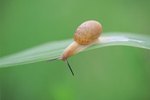
American horseshoe crabs have a unique anatomy that's changed very little in the past 20 million years. Limuli polyphemus, or horseshoe crabs, aren't really crabs, but are closely related to scorpions, spiders and ticks. Their bodies are horseshoe-shaped and have three sections: the prosoma in front, the hinged opisthosoma in back and the telson -- a hard, spiny, pointed tail. They don't have jaws or teeth, and must walk while they're eating.
Diet
Horseshoe crabs are bottom-feeders, trolling along the sand and mud at the bottom of shallow waters. Omnivores, they scavenge for small mollusks, aquatic worms, algae and carrion. Feed your captive horseshoe crabs a diet of dehydrated algae, fish flakes, and small pieces of shrimp and squid.
The Mechanics of Eating
Horseshoe crabs have no jaws or teeth, but they do have mouths. The mouth is centrally located, surrounded by 10 pairs of legs. Four pairs of walking legs tear and shred the food before pushing it into the mouth. From the mouth, the food is passed through the esophagus, the proventriculus, and a sand-filled gizzard for final grinding before entering the stomach.
Gnathobases
The gnathobases are sharp, spiny areas located on the middle sections of the pedipalps, or walking legs. Tiny hairs on the gnathobases enable horseshoe crabs to smell the food. Inward-facing spines tear and shred the food, passing it through their legs as they walk. They have to be on the move to chew their food.
Chelicerae and Chilaria
The chelicerae are a pair of anterior appendages found in front of the pedipalps. Horseshoe crabs search along the sandy bottoms of shallow waters seeking food with their chelicerae. The chilaria are a pair of small, underdeveloped posterior legs, situated behind the pusher legs. The chelicerae and the chilaria pass the shredded particles of food into the horseshoe crab's mouth.
References
Photo Credits
-
Hemera Technologies/AbleStock.com/Getty Images
Writer Bio
Karen Mihaylo has been a writer since 2009. She has been a professional dog groomer since 1982 and is certified in canine massage therapy. Mihaylo holds an associate degree in human services from Delaware Technical and Community College.



